The curtain of aluminum-glazed windows falling from the curved steel roofline that frames the Lewis Library is a reflection of the architect's homage to the beauty of the lines and curves he sees in everyday life.
Sheer glass walls of two rising wings play with spatial boundaries that typically would separate the interior and exterior of the building. The windows allow the eye to travel in one glance from the inside of one part of the building, to the outside, to the inside, and to the outside.
"The designs are inspired by the visual world that surrounds us and by art," design architect Frank Gehry said, explaining his inspiration. "Many times we refer to painting and sculpture. Sometimes it's more about how an artist sees and interprets a subject or how an artist uses a shape or a material.
"Sometimes we are inspired by everyday objects that have beautiful shapes," he added. "Sometimes we are inspired by the energy and life of the cities in which we work."
The Gehry-designed Lewis Library officially opened with the start of Princeton's academic year Thursday, Sept. 11. After almost four years of construction, the library brings together science libraries from across campus in a research and study space that is, according to the architect, intended to reflect the character of the people who will use it.
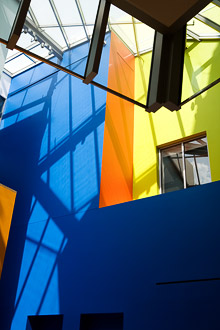
Large, adjacent walls in the new library are painted in such colors as bright blue, orange and chartreuse.
Supported by a $60 million gift from class of 1955 alumnus Peter B. Lewis, a University trustee and chairman of the board of Progressive Corp., the Lewis Library houses the collections for astrophysics, biology, chemistry, geosciences, mathematics, physics and statistics. Also in the building are student classrooms and seminar rooms; the University's map collection; the digital map and geospatial information center; the Office of Information Technology's (OIT's) Education Technologies Center and its New Media Center; a new Broadcast Center operated by OIT and the Princeton Institute for Computational Science and Engineering; and OIT's computational science and engineering support group.
The bold lines of the library should serve as inspiration for these groups, Gehry said.
"The design of the interior of the Walt Disney Concert Hall was intended to provide a visual environment to be seen while listening to music," explained Gehry, who also designed that structure in Los Angeles. "The curving lines lead the eye around the room and create an abstract visual landscape that would enhance the experience of the music.
"It may be true that a similar experience may happen in the Lewis Library. Scientists who are focused on complex issues may find that the abstract landscape of the building will stimulate their imagination and perhaps lead them to thinking outside the box."
Standing in the main library's highest level, for example, there are alternating glimpses of color outside every window -- shades of green, purple and orange.
"It's great to be in the main lobby space at different times of the day and to see how the light changes as it casts shadows from the mullions of the skylights onto the colored walls," Gehry said. "As the light shifts, the colors reflect onto the glass and walls. The colors move from one surface to another in ever-changing patterns. Some of the walls take on the color of walls on the other side of the lobby.
"The reading rooms in the library tower face to the north, and the quality of indirect sunlight in these spaces creates an ambient effect that is quite beautiful."

The main entrance to the building features a multi-story atrium with skylights. "It's great to be in the main lobby space at different times of the day and to see how the light changes as it casts shadows from the mullions of the skylights onto the colored walls," Gehry said.
Considerations in the design process
Moving beyond the building itself, Gehry said it also was important that the Lewis Library be "a good neighbor" to the buildings surrounding it.
There are many design styles on campus, but rather than attempt to fit into a particular aesthetic, one primary goal was to help create a visual context for neighboring Fine Tower. The academic building for the mathematics department had previously been a very tall, but solitary, physical statement.
"The massing of the building is developed into an architectural expression which is a response to the material, colors and textures of the context buildings," Gehry said of his design process for the library. "A sculptural body-language develops out of these responses and evolves with development of the design. This is how we work."
The 88,000 pounds of embossed stainless steel and 620 tons of clay brick that were combined with the glass, steel and stucco for the Lewis Library were selected as materials because they were reflected in the buildings nearby.
"We have matched the scale and texture of these neighbors," Gehry said. "We have also tried to make a better relationship between the smaller buildings on Ivy Lane and the Fine Tower by placing smaller building elements on the lane and placing the library tower closer to Fine. This stair-stepped design makes more of a family of the buildings on the site."
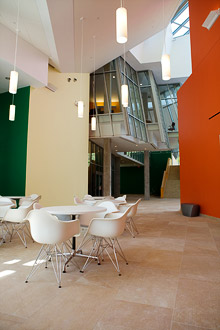
The 100 level of the Lewis Library features an area called "The Street," which offers café seating and an entrance to the library.
Mark Burstein, Princeton's executive vice president, said the cohesive nature of Gehry's design is one of its greatest benefits.
"Lewis Library provides an excellent anchor on the Ivy Lane/Western Way corridor for development," Burstein said of the roadway along the eastern area of campus, where the library now abuts Washington Road. "With Peyton (Hall) -- the home of our astrophysics department -- as a neighbor, the new science library sets the context for academic development eastward.”
A 10-year Campus Plan completed by the University this spring establishes a framework for future campus development, and presents the Ivy Lane area as a pivot point for the campus. The plan proposes a new academic neighborhood in this location over the next 20, 30 or 40 years that would combine the natural and applied sciences.
Burstein said the Lewis Library is a "linchpin" that pulls both areas together.
"What better way to do that than with the science library?" he said. "And what better match than one of the modern masters with our natural sciences endeavor? The connection between the building's program -- an integrated science library and the University's science and engineering research computing effort -- with the architecture makes the building an excellent contribution to the campus. Gehry has also designed a building that takes full advantage of the marvelous campus vistas from the inside looking out.”
Peter Lewis, for whom the library is named, said the building makes a powerful statement about Princeton's commitment to excellence in the sciences.
"It also brings together two things that are very close to my heart -- Princeton University and the architecture of Frank Gehry," said Lewis, a longtime friend of the architect. "The building represents the kind of inspired risk-taking that is necessary for education and progress, and I am thrilled that Princeton has embraced Gehry's unique architecture on its campus."
While the Lewis Library design itself differs significantly from other architectural styles currently represented on campus, that difference in a way is typical of Princeton, Burstein said.
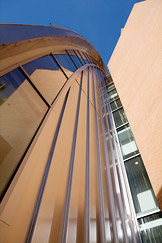
For the roof, steel beams were individually made and then built into the curved shape.
A departure in Princeton's architectural landscape
Burstein explained that Princeton's architectural history has been marked by departures in style that helped build the rich tapestry of architecture that today distinguishes the campus.
"Quite frankly, at the time our first Collegiate Gothic structure was built, it was a departure," Burstein said of the late 19th- and early 20th-century architecture of many of the University's dorms and academic buildings that today is often referred to as traditional Princeton. "Before that, the campus was a collection of buildings designed in the colonial and Victorian styles."
The modern style of Robertson Hall, designed by Minoru Yamasaki in 1966, was considered an architectural departure when it became the home of the Woodrow Wilson School of Public and International Affairs; the post-modern Wu Hall, designed by class of 1947 alumnus Robert Venturi, was seen as a "radical" design when it was erected to serve as a dining hall for the Butler College undergraduate student residential complex in the 1980s; and today, some may say the same about the Lewis Library.
"One of the important strengths of our physical campus is architectural diversity harmonized with landscape and architects' efforts to design within context," Burstein said. "Lewis Library is an excellent addition to this composition of buildings."
While the Lewis Library catches the eye because of its sculpted steel curves and bold colors, it helps exemplify the way in which the architecture on Princeton's campus is coming to reflect a new direction in using technology in design.
"Although we have used technology for modeling and design on many campus projects, including the new chemistry building designed by Michael Hopkins, the Lewis Library project pushed our use significantly,” Burstein said.
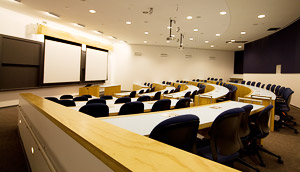
Two bowl-type classrooms -- one seating about 75 and the other about 50 -- are located on the first floor.
What distinguished the Lewis Library from the other buildings is that the development of the library's complex structure of curved steel, sloping glass walls and concrete and stucco towers relied at a basic level on technological intervention from concept to completion.
"The technical solutions to construction are an integral part of our design process," Gehry said. "They develop right along with the architecture and inform the creation of shapes. Many times we need to invent a new way of putting things together to get the shapes we are after. We have a very creative technical staff, and we use computer models to fully explore design methods before we get the projects under construction."
The technology evolution in campus design
The library was constructed using a trademark computer modeling process never before used in Princeton's construction history.
Project manager Henry Thomas of the University's Office of Design and Construction explained that the project was made possible by "Digital Project" software engineered and marketed by Gehry's firm Gehry Technology to operate on a computer platform known as CATIA.
Short for Computer-Aided Three-Dimensional Interactive Application, CATIA is a programming platform on which software was developed originally in the 1970s and early 1980s to build aircraft. The platform was later adapted for use with software to build submarines and automobiles, and Gehry Technology adapted it further for Gehry's postmodern building design.
"The CATIA model provides a way of controlling all dimensions of the project. It eliminates the ambiguity," Thomas said.
Rather than go to a printout of an architectural drawing of the library, project managers and contractors routinely consulted a computerized three-dimensional model. The model was built using software that digitized the block form masses that Gehry Partners typically uses to represent Gehry's design. The software cut planes through the digitized version of the block model to generate two-dimensional drawings that were then fed into a design platform known as AUTO-CAD, which is the industry standard for building design.
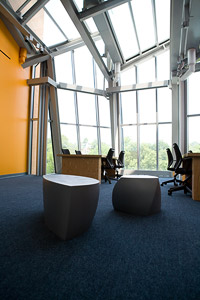
A large research and study area on the 400 level features gray tables and chairs designed by Gehry. The room offers views of the stainless steel roofs below and the campus beyond.
The architectural plans do not have dimensions written on them, as more traditional plans would. Rather, the builder can extrapolate dimensions and x, y, z coordinates from the digital model.
The contractors were able to use the software to determine every possible element related to dimensions and materials, including such elements as the volume of concrete they would need, how many square feet of carpet and drywall to purchase, how many bricks they would use and how much mortar would go into the project.
"You couldn't build a building like this without the modeling software," said Greg Ondick, architectural project manager for Barr & Barr Inc. Builders, the New York-based general contractor for the project. "It tells us where to put a brick, where to erect a beam, how much glass to cut -- before I gave any kind of direction on how to proceed, I came back to look at the model."
In a demonstration of the modeling software, Ondick showed how he was able to rotate the entire building, highlight all parts of the structure made with concrete, glass, wood or any other individual building material, and zoom in on a single beam to learn its full dimensions, its distance from the edge of the room, and its elevation above sea level. This directed contractors and subcontractors on the precise placement of project elements in relation to other elements.
"The seams on the roof, for instance, are located relative to the lines of rule that dictate the geometry of the entire structure," Ondick said.
In another example, achieving the shapes and the geometry for bending the drywall for a unique star shape that frames an opening between two floors of the library in Gehry's design were difficult because drywall workers typically work with 2D drawings. But they had to do the job only once, thanks to the CATIA software.

A star-shaped opening between two floors of the library is one unique design element of the library. It is surrounded on the 200 level by periodical shelves.
Trademark Gehry finishing touches throughout the building also were designed with the software, including the wavy lines of the canary-yellow welcome desk -- a main attraction in the first-floor entrance to the library.
"We worked with the library staff on these elements, making full-scale mockups and having the staff test and comment on the design," Gehry said. "During one mockup review, we cut and rebuilt the mockup on the spot based on their comments. They placed their computers and other equipment on the mockup to make sure it would fit. We selected all of the loose furniture in the building also in collaboration with the librarians."
The science librarians, OIT staff, and the support staff for computational science and engineering spent the summer moving into the building while interior design work was being completed in the library.

Lights were installed to hang from a ceiling reaching almost 34 feet in the second-story "tree house," so named because the expansive, glass-enclosed room skims the tree line and looks out into neighboring tree tops.
An assortment of deep blue, green, red, yellow and black desk chairs were wheeled into the 14 group-study and seminar rooms while the registrar's office determined which classes would meet in the building during the year; angled gray tables and chairs reflecting the Gehry geometry were placed throughout reading areas and common spaces; and lights were installed to hang from a ceiling reaching almost 34 feet in the second-story "tree house," so named because the expansive, glass-enclosed room skims the tree line and looks out into neighboring tree tops.
Now that it is complete, Gehry said he hopes all who use the building find delight in its features.
"We hope that the library will be a great place to study and hang out, and that it will fulfill the needs of the community of scientists that will use it," Gehry said. "We hope that students will enjoy the experience of being in the building, of seeing the forms and color, and how the light comes down through the spaces."
For those who ask what the building will mean to the future generations of students and researchers who will use it, Gehry said its meaning derives from the University's choice to support the design.
"It means that the institution is looking to the future," he said.

The Lewis Library is a reflection of the architect's homage to the beauty of the lines and curves he sees in everyday life. "The designs are inspired by the visual world that surrounds us and by art," Gehry said.





